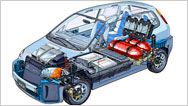Air Bag Design
- Teacher Resource
- Posted 05.09.06
- NOVA
Do you need proof that driving is a dangerous activity? More Americans have died in car crashes over the past 100 years than in all the wars the U.S. has ever fought combined. More than 40,000 Americans die each year on the nation's highways, most as the result of high-speed collisions. In this video segment adapted from NOVA, learn how engineers developed the air bag, an important automobile-safety device now found in most cars.


- Media Type: Video
- Running Time: 3m 02s
- Size: 9.1 MB
- Level: Grades 3-12
-
Log in to Teachers' Domain to download, share, rate, save, and match to state standards.
Source: NOVA: "Escape! Because Accidents Happen—Car Crash"
This resource was adapted from NOVA: "Escape! Because Accidents Happen"—Car Crash."
Background
The next time you're riding in a car, think about this: Almost every new car today is equipped with safety belts, shatterproof glass, padded dashboards, front and rear bumpers, anti-lock brakes, and crumple zones — each engineered and tested to perform to high standards established by government safety boards. Judging by this built-in redundancy, it is clear that many safety devices must work in concert with one another to achieve the desired safety goal.
As described in this video segment, air bags, another now-common safety feature, are a type of passive restraint system, meaning they restrain motorists without the people in the car actively doing anything. Air bags were conceived at a time when fewer than 15% of all U.S. drivers and passengers wore safety belts. The government, concerned by the high rate of highway fatalities, pressured automakers to build more safety features into their vehicles.
How can an air bag prevent serious injury? In order to answer this question, it is necessary to understand what happens in a motor vehicle collision. According to Newton's laws of motion, an object moving at a constant velocity continues at the same velocity unless an external force acts upon it. Applied to a car crash, a body inside the car continues moving forward at the same velocity as the car was moving prior to impact. It stops only when it hits some object in the car, such as the steering wheel or dashboard. When the force of impact is large enough, injuries occur.
An air bag protects a passenger by applying a significantly smaller restraining force to the body than it would have experienced if it hit the dashboard or steering wheel unprotected. Additionally, an air bag helps reduce injuries by distributing the force of the collision over a larger area, thus lessening the force on any particular part of the body.
Just as real-world data showed early safety-belt designers that their invention sometimes caused more damage than it prevented, air bag engineers learned that the explosive force of a rapidly expanding air bag was powerful enough to injure and even kill smaller adults and children. So they went back to the drawing board and designed a smarter system. Early air bags inflated with a specified force and were tested exclusively on adult-sized male dummies, but new computerized systems have sensors that take into account the force of impact, the size of the passenger, and even whether the seat belts are engaged. Based on these data, computer calculations determine whether or not deployment is required, whether a bag should deploy from the front or from the side, and how forceful the deployment should be.
To learn more about the steps of the engineering design process, check out What Is the Design Process?.
To learn about how bicycle helmets offer protection to arguably our most critical organ, check out Balloon Brain: Designing a Helmet.
Design a study of local seat belt use in this NOVA classroom activity.
Questions for Discussion
- What problem were the engineers asked to solve?
- What were some of the challenges faced by engineers when designing the air bag?
- What might be some of the reasons that the airbags burst during the design phase?
- Explain the value of testing design ideas.
Related Resources
-

Car of the Future
Student teams research and develop a proposal to decrease carbon footprint of their city's public transportation system.
-

Clickable Fuel Cell Car
Take a look inside a prototype hydrogen fuel cell car and see what makes it go.
-

Making Air Travel Safer
Horrifying as they are, the worst airline accidents spark the most safety improvements.





